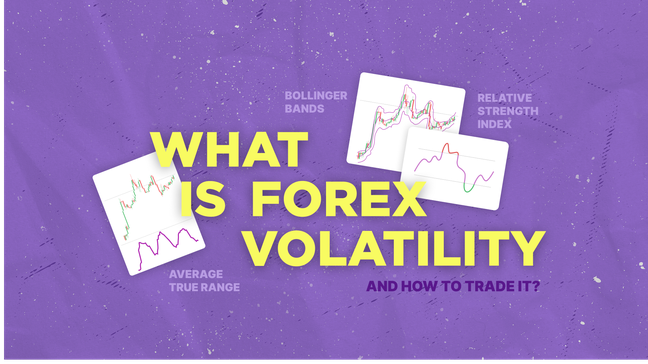What Is Forex Volatility and How to Trade It?
Forex volatility depicts a rapid change in the currency exchange rate. The Forex market is one of the most traded and highly-volatile sectors. This is why it attracts millions of traders from across the globe. It offers round-the-clock access letting investors buy and purchase assets 24/7 utilizing various Forex strategies and methodologies depending on their preferences.

However, even the most proven and well-tested technique will never work without an understanding of FX market volatility. This supreme knowledge will let one understand not only which particular currency is better to trade right now but also how to trade it.
In this article, we will discuss the meaning of Forex market volatility, what assets to trade and what indicators to use for backing your approach and making the most of it from a profit perspective.
Forex Volatility Meaning in Trading
In simpler words, FX volatility is a tool to measure the changes in the currency value. Additionally, it helps to understand how frequent the value moves are. It lets you properly react to the market change and take action accordingly.
Forex market conditions can be associated with high or low currency volatility. It mainly depends on how far the asset value derivates from the average level. So, we can say that FX market volatility also helps to measure standard deviation.
When traders say “high volatility”, they also mean higher risks. At the same time, with higher volatility, one has more chances to win big, as the currency prices move bigger as well.
up to 200%

from 0 pips

Trading platform

Trading Tricks to Identify Forex Market Volatility
By its nature, Forex volatility is impossible to predict. However, traders can still use some techniques that help to measure it. It provides a foundation for accurate predictions of what is about to happen with the currency value.
To identify FX market volatility, we need to divide them into two major types:
- Historical Forex Volatility. It has already taken place. You can track how it affected the market in the past. It can be tracked via Forex charts.
- Implied Forex Volatility. It measures the future expectations of market participants. It can be tracked via CBOE indices.
How to Trade Forex Market Volatility
The following tips will let you make the most of your Forex strategies and take them to a new level. What is even more important, with these steps one can make his or her approach less risky, which means protecting your balance from disastrous losses.
1. Trade across Events and New
As a Forex trader, you will have to monitor and track news and current affairs on a daily basis. The slightest event or announcement can have a crucial economic effect that will impact the value of the asset. You can see this happening when Forex volatility takes place together with political turbulence or economic uncertainty.
2. Set Stop Losses
Using stop losses is always a good practice as a part of your risk management strategy. It becomes essential when trading in a volatile market. First of all, you can set a stop loss at a specific level considering the worst scenario. Secondly, it will ensure any potentially losing trade is accounted for in advance. This factor is vital for traders who use leverage, as their losses during rapid price changes can be significant.
3. Stick to Small-Size Positions
Another tip is to keep the size of positions as low as possible. Amateurs are mostly seduced by the chance to win big during Forex volatility. Oppositely, experienced traders always stick to the plan and try to keep emotions aside. Experts recommend risking not more than 5% of the initial capital. Otherwise, you will not have enough room to handle positions.
4. Practice Your Strategy
Beginners should start by adhering to their single strategy instead of jumping from one approach to another. Besides, it is very important to have a transparent trading plan.
5. Keep a Forex Trading Journal
A trading journal will let you easily track all your previous trades and analyze them. It can bring maximum value when trading during Forex market volatility making it possible for investors to look back and improve the approach by taking into account previous mistakes. Make sure a trading journal is well-maintained. It will be a huge step forward to becoming a successful Forex trader.
6. Use Forex Charts and Indicators
You will need several technical tools to identify FX market volatility. Some are good for making accurate predictions on how the currency price will move. Others make it possible to evaluate market sentiments.
Here are some popular Forex indicators to use when trading Forex volatility:
- Bollinger Bands. The indicator will come in handy whenever you need to identify a bullish or bearish market. As a result, you can predict how the price will move further. In case of an oversold or overbought market, the price generally moves oppositely.
- Average True Range. It helps to measure volatility. Additionally, traders can apply it when setting the most favorable market exit conditions combined with a trailing stop loss to minimize potential losses.
- Relative Strength Index. Another tool is to detect the overbought or oversold currency and decide how the price will move further.
Stable vs High-Volatility Currencies
If you look for currencies with maximum volatility, you should be ready for frequent and rapid Forex price fluctuation. They are generally introduced by exotic currency pairs such as USD/ZAR or USD/TRY. If you look for a more stable asset with minimum risk, you should opt for major currency pairs such as EUR/USD, EUR/GBP, NZD/USD, and some more.
The Bottom Line
Forex volatility can bring some great opportunities to win big and gain wealth. However, it also comes with higher risks. This is why it is very important to use specific tools and indicators that help to identify the market conditions and make accurate predictions on further price moves. Additionally, volatility traders should never ignore at least baseline risk management tools, especially when trading with leverage.
This material does not contain and should not be construed as containing investment advice, investment recommendations, an offer of or solicitation for any transactions in financial instruments. Before making any investment decisions, you should seek advice from independent financial advisors to ensure you understand the risks.
